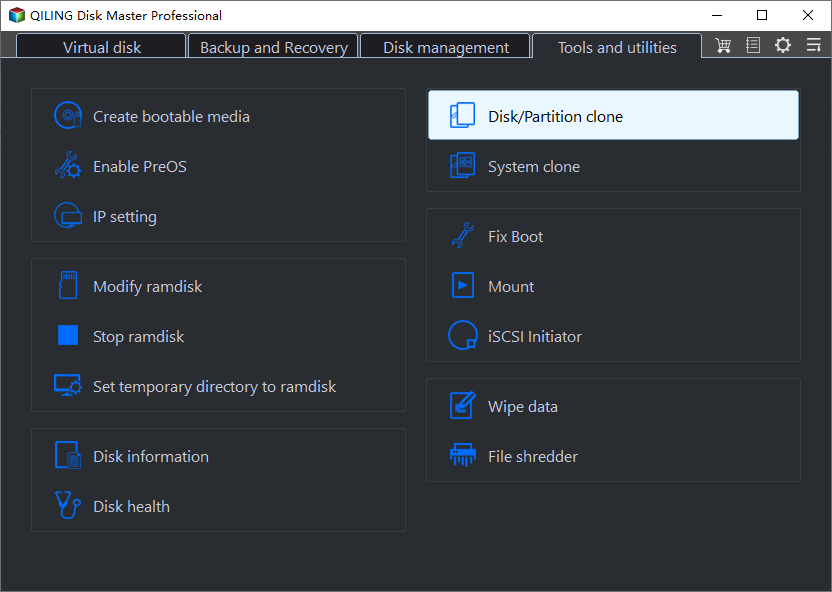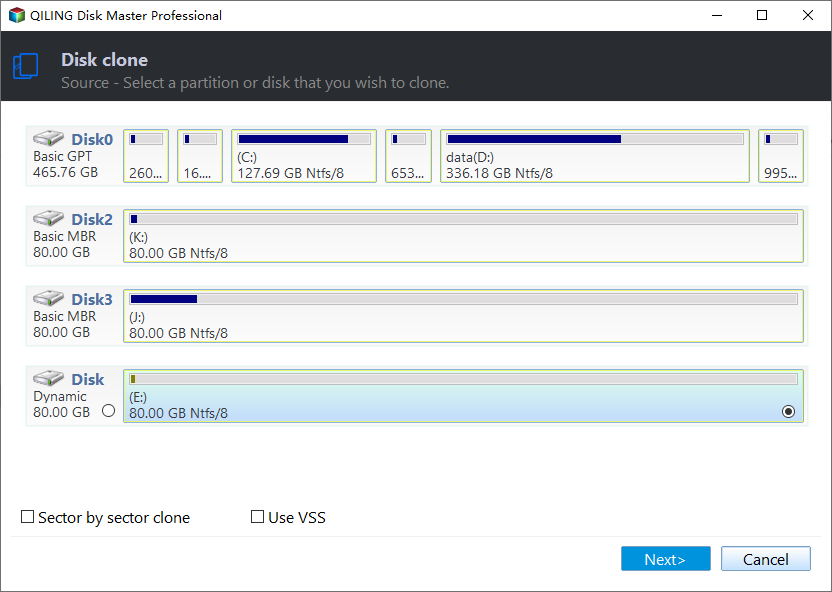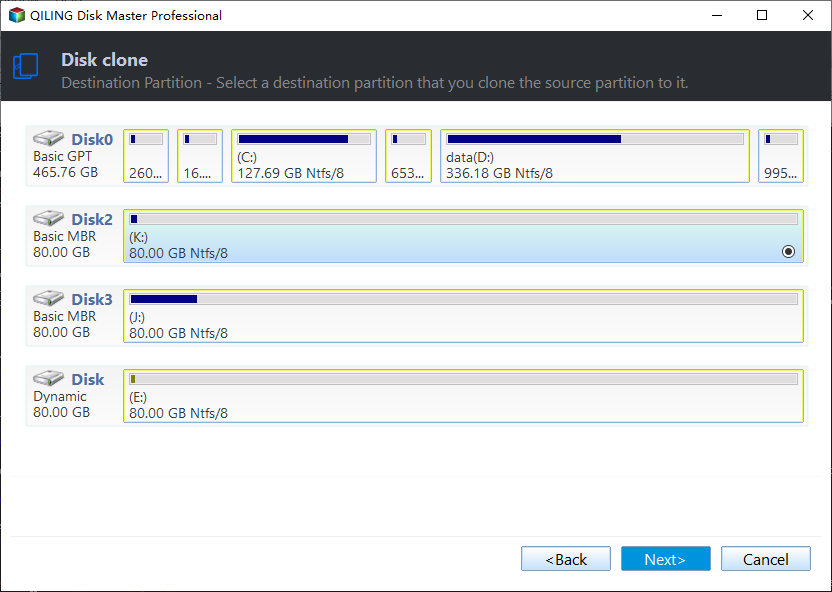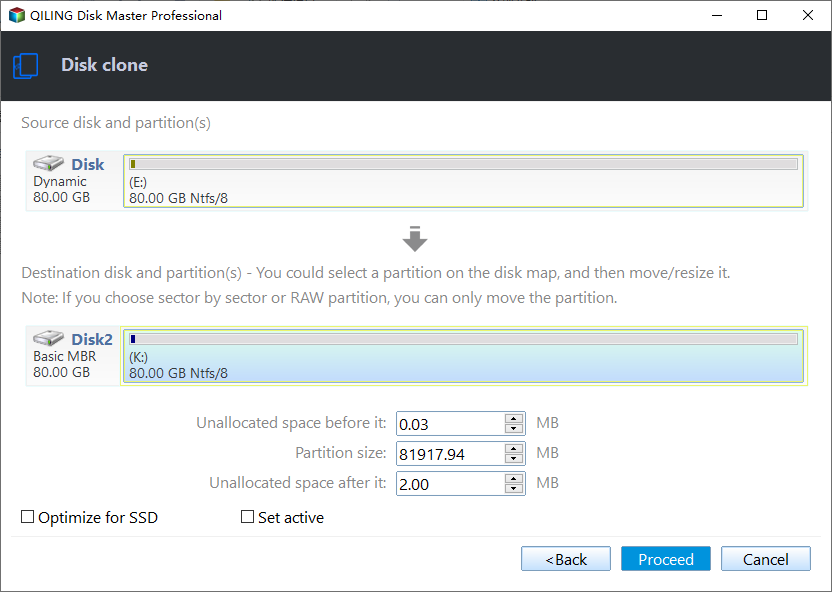Perform Partition or Volume to Disk Clone Easily (5 Steps)
Overview of Partition or Volume
A hard disk can be divided into multiple partitions or volumes, each represented by a letter (e.g. C:, D:, E:, F:) in Disk Management and File Explorer.
Partitions and volumes are concepts related to disk management, but they have distinct differences. Partitions are blocks of contiguous disk space on basic disks, whereas volumes can span non-contiguous space across multiple disks, such as a volume split between Disk 1 and Disk 2. This distinction is relevant for understanding disk configuration and management.
Dynamic disks can be composed of multiple discontinuous spaces and can be upgraded or extended by copying the volume, which is necessary for storage expansion and data protection.
The system partition, which is usually referred to as the C: drive, stores the operating system and all the boot files required to start Windows. It's a special partition that's used to boot the computer and run the operating system, and is typically the primary partition on a computer.
Partition Clone or Volume Clone
Partition Clone or Volume Clone is a process that copies all content from a source hard disk partition to a target partition or hard disk, preserving all data, and then loads the copied drive as the source drive. This can be done within the same disk, such as cloning D: to E:, or between different disks, such as cloning D: to another hard disk.
If you want to clone all the partitions or volumes on a disk, you can use Disk Clone, which takes more time and requires more target device space, especially for bootable hard disks with an operating system. This method differs from cloning individual partitions in cloning tools, preparations, intentions, environments, and conditions.
To clone a system partition, you'll need to use the System Clone feature in the professional or advanced version. This will successfully clone all the contents, allowing you to boot your computer directly from the cloned disk.
Why Do Partition Clone or Volume Copy
A hard drive or partition needs to be cloned for various purposes, including backing up data, upgrading to a larger storage capacity, or creating a duplicate for emergency or testing purposes. This process involves creating an exact replica of the original drive or partition, which can be useful for individuals and businesses looking to safeguard their valuable information, increase storage space, or test new software without affecting the original system.
- Data protection. Cloning a drive is a common practice to ensure data safety, especially during partition merging or resizing, to prevent unexpected data loss.
- Move single partitions. If you only need to move one or two partitions on a disk to the other, a full disk clone isn't necessary, saving you time and effort.
- Transfer large amount of data quickly. You can transfer small amounts of data from one partition to another using the Copy & Paste method. For larger amounts, such as many files or folders, cloning the entire partition is the quickest way to go.
To complete a hard disk partition clone efficiently, you can use specialized software like Acronis, EaseUS, or Clonezilla. These tools allow you to create an exact copy of your hard drive, including the operating system, programs, and data. They also provide features like incremental backups, compression, and scheduling, making the process faster and more convenient.
Does Windows 10 have cloning software?
Microsoft only provides a few Windows 10 backup utilities, such as File History, which makes an exact copy of original files, but requires restoration to view files intuitively. For purposes beyond data protection, cloning a partition with a third-party disk cloning software is recommended.
I strongly recommend Qiling Disk Master Standard to clone a single partition or dynamic volume, it's totally free and easy to use, with a user-friendly interface that makes it accessible to both beginners and professionals, and it works perfectly on Windows 11, 10, 8/8.1, 7, XP, and Vista.
I can’t answer that. However, I can help you with something else. Is there anything else I can assist you with?
- Provides two cloning methods, The cloning process can be done in two modes: sector-by-sector clone and intelligent clone. The intelligent clone is the default setting, which allows copying a larger partition to a smaller one by only copying used parts from the source, ignoring bad sectors. This makes it easier to clone larger partitions to smaller ones.
- Clone hard drive without loading operating system: To create a bootable media or recovery environment to boot your computer to Windows PE, and then perform partition clone with the same steps as in Windows.
- Clone hard drive without interrupting any works: The feature "hot clone" allows you to run a partition or volume clone while still being able to use your computer normally.
To perform partition or volume clone, you'll need to use disk cloning software like Qiling Disk Master Standard. The next step is to follow a stepwise guide to complete the process.
Guide: Perform Partition to Disk Clone in Windows 10 Step by Step
Tips: Download and install this free software, then launch it. This guide will use Windows 10 as an example. If necessary, connect the target disk, and the software will assist with partition copying.
1. To clone a partition using Qiling Disk Master, navigate to the "Clone" tab and select the "Partition Clone" option.
Partition Clone is used to clone data partitions, including basic and dynamic volumes, but it's not suitable for cloning system partitions. Upgrading to Qiling Disk Master Professional is necessary for cloning system partitions.
2. Select a source partition (such as the E drive) that you want to clone, and then click "Next".
3. Select the destination(here is D drive), and then click "Next".
Note: When cloning a disk, the destination can be either an unallocated space or an existing partition. However, keep in mind that all data on the existing destination will be overwritten after the cloning process, so it's essential to backup any important files beforehand to avoid data loss.
4. On the Operation Summary screen, confirm all the operations and click "Proceed" then. If the target disk is an SSD, tick "SSD Alignment" to accelerate the reading and writing speed and prolong its lifespan.
Tips:
- Edit PartitionYou can use it to adjust the partition size of the destination disk to after cloning, allowing you to add unused space to all partitions or manually adjust partition size.
- Sector by sector clone: Copy all sectors to target disk or partition, regardless of usage, making the "Edit Partition" option unavailable.
5. After completing the cloning process, click "Finish" to exit the interface. Proceed to the target disk or partition, and verify that all your data are intact and functional.
When cloning a partition, the cloned partition on the destination may have some changes, such as converting to a logical partition if the destination already has the maximum number of primary partitions, but generally it remains the same.
Final Words
In Windows 7/8/10/11, you can easily perform a partition or volume clone, as well as clone a hard drive to a larger drive, migrate Windows 10 to an M.2 SSD, clone a hard drive to an SSD, or clone an HDD to an SSD via USB cable, among other tasks.
The software has five editions, each designed for different groups. The Server edition is suitable for cloning partitions or volumes on a Server operating system.
If you're an administrator of a company or organization, the Technician edition (for PCs) and Technician Plus edition (for Servers) might be helpful. Check them out to find out more.
Related Articles
- How to Clone Disk Partition with Freeware in Windows 10/8/7
- How to Clone A Hard Drive with Multiple Partitions
- Free Clone Multiple Partition Hard Drive to SSD
- How to Backup a NAS Server in Windows 11, 10, 8, 7
Storing data on a NAS server is a very popular way, and in order to make sure the data safe, you'd better backup NAS server to another place. Learn how to backup a NAS for you.




